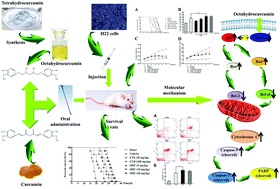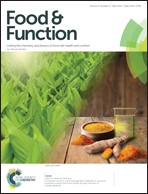Octahydrocurcumin, a final hydrogenated metabolite of curcumin, possesses superior anti-tumor activity through induction of cellular apoptosis†
Abstract
The biological activity of curcumin (CUR), a promising naturally occurring dietary compound for the treatment of hepatocellular carcinoma (HCC), was closely associated with its metabolite. Octahydrocurcumin (OHC) is the final hydrogenated metabolite of CUR and has been reported to have potential biological activities. However, difficulties in access have hampered its biological studies. In the current investigation, we designed an efficient synthesis method to produce OHC, and comparatively explored the anti-cancer effect and potential mechanism of OHC and CUR in an H22 ascites tumor-bearing mice model. The results indicated that OHC had a relatively wide margin of safety, and exhibited superior effects to CUR in suppressing the tumor growth, including ascending weight, abdominal circumference, ascites volume and cancer cell viability. OHC significantly induced H22 cell apoptosis by upregulating the p53 expression and downregulating the MDM2 expression. OHC also remarkably decreased the Bcl-2 and Bcl-xl protein expressions, and increased the Bax and Bad expressions in ascitic cells. Furthermore, THC substantially induced the release of cytochrome C, caspase-3, caspase-9 and the cleavage of PARP to induce H22 cell apoptosis. Taken together, OHC was more effective than CUR in suppressing H22-induced HCC through the activation of the mitochondrial apoptosis pathway. OHC may thus be a promising anti-HCC agent.



 Please wait while we load your content...
Please wait while we load your content...